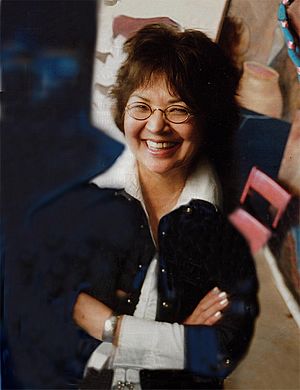Joane Cardinal-Schubert facts for kids
Quick facts for kids
Dr.
Joane Cardinal-Schubert
LL.D (Hon), R.C.A.
|
|
|---|---|
 |
|
| Born | 1942 |
| Died | 2009 |
| Nationality | Kainai Nation, Canadian |
| Education | BA, BFA, LL. D (Hon), R.C.A. |
| Alma mater | Alberta College of Art and Design, University of Alberta, University of Calgary |
|
Notable work
|
Drum Dancer "aka Prairie Pony", "Song of My Dream, Bed Dance" |
| Style | Installation, Mixed media, Painting |
| Awards | Honorary Doctor of Laws, University of Calgary |
Joane Cardinal-Schubert (1942–2009) was an important Indigenous artist from Alberta, Canada. She was a member of the Kainai Nation and the Royal Canadian Academy of Arts. Joane was also an activist who worked to support Indigenous rights and culture.
Contents
Early Life and Learning
Joane Cardinal-Schubert was born in 1942 in Red Deer, Alberta. In 1962, she started studying art at the Alberta College of Art + Design. There, she learned about painting, printmaking, and other art forms.
During her education, Joane noticed that Indigenous culture was often left out of school lessons, media, and history books. This made her focus her art on her own family history and her Kainaiwa background.
Higher Education and Career
In 1973, Joane began studying at the University of Alberta. She later moved to the University of Calgary, where she earned her Bachelor of Fine Arts degree in 1977.
After university, she worked at art galleries in Calgary. She was an assistant curator at the University of Calgary Art Gallery and the Nickle Arts Museum. A curator helps organize and display art shows. Joane also wrote many articles about art for magazines, books, and exhibition catalogs around the world.
Her Amazing Artwork
Joane Cardinal-Schubert's paintings and art installations tell stories. She often combined her own experiences with important social and historical events. Her art often showed strong Indigenous symbols. It also talked about issues that affected her and her community.
She often explored themes like colonialism and environmental damage in her work. Sometimes her art showed a shared Indigenous experience. Other times, it was influenced by modern art styles from around the world.
Joane once explained how her art was seen: "It was hard for me to realize my art was put into a special group just because of who I was. Non-Native curators often labeled my work, and others' work, as 'Native Art.' This happened even though I had the same art education as everyone else. When I finished school, my art, which was about myself and my feelings about the world, was called 'Native Art' and 'political art.' Later, when Indigenous curators started working, they also called it 'Native Art.' But this was different. We were choosing to say who we were, not being told by others."
Her art helped people understand Indigenous experiences. It also questioned how European education, religion, and government systems affected Indigenous peoples. She also explored how museums handled Indigenous artifacts. She wanted to challenge the idea that museums had complete control over these items. Joane wanted her art to help viewers connect with Indigenous issues in ways they could understand.
Awards and Recognition
Joane Cardinal-Schubert received many honors for her work. In 1985, she became the fourth woman ever to join the Royal Canadian Academy of Arts.
She received the Commemorative Medal of Canada in 1993. In 2003, her old university gave her an honorary doctorate degree. She also received the Queen's Golden Jubilee Medal in 2005. In 2007, the National Aboriginal Achievement Foundation (now called Indspire) gave her their Art Award.
In 2017, a new high school in Calgary was named after her. It is called Joane Cardinal-Schubert High School. This was a special moment because it was only the second high school in Calgary named after a woman.
Her Indigenous Heritage
Joane Cardinal-Schubert was a proud member of the Kainai Nation. The Kainai, also known as the Blood Tribe, are a First Nation group in southern Alberta, Canada. They are part of the Niitsítapi, or Blackfoot Confederacy. The Blackfoot Confederacy includes the Kainai, Peigan, and Siksika nations. They are considered some of the oldest residents of the western prairie region.
The Kainai people have always been very independent and proud of their identity. This strength helped them resist attempts by governments and churches to change their traditions. They successfully protected their legal rights and cultural identity.
Joane played a big role in creating a place for Indigenous art in Canada. She fought for Indigenous artists to have their work shown in galleries and museums. In 2009, she traveled across Alberta. She met with Indigenous artists to find their artwork and recommend purchases for the Alberta Foundation for the Arts. This helped Indigenous artists and made their work available for future generations.
Her work as an artist, activist, curator, and writer helped share important truths about Indigenous history, culture, and current issues.
Selected Artworks
- Baptismal — The Convent Series, Medium: acrylic on canvas, Size: 40 × 40 inches
Exhibitions
Joane Cardinal-Schubert showed her art in many places, both in Canada and internationally. She had over 26 solo exhibitions and was part of many group shows that traveled to different cities.
- Beyond History at the Vancouver Art Gallery (1989)
- INDIGENA: Perspectives of Indigenous Peoples on Five Hundred Years at the Canadian Museum of Civilization (1992)
- Joane Cardinal-Schubert: Two Decades at the Muttart Public Art Gallery (1997)
- Preservation of a Species: Cultural Currency, The Lesson, Articule Gallery. Montreal, Quebec (1990)

